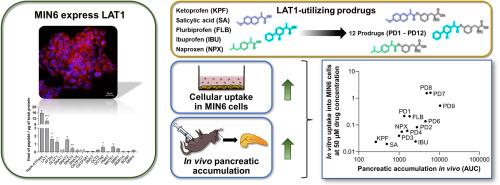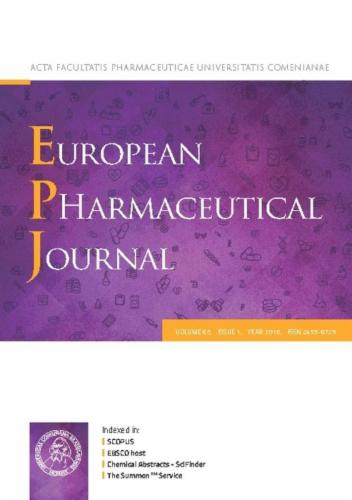L 型氨基酸转运体 1 可增强对小鼠胰腺 beta 细胞系 (MIN6) 的药物输送。
IF 4.3
3区 医学
Q1 PHARMACOLOGY & PHARMACY
引用次数: 0
摘要
l 型氨基酸转运体 1(LAT1)是一种膜转运体,负责将大型中性 l 型氨基酸以及适当的(原)药物带入细胞。它在改善药物通过血脑屏障的输送以及增加细胞对几种脑细胞和癌细胞类型的吸收方面显示出巨大的潜力。然而,除了脑部,LAT1-利用化合物在体内也能更有效地输送到胰腺。在这项研究中,我们量化了小鼠胰腺β细胞系(MIN6)中 LAT1 和其他几种膜转运体的表达。此外,我们还研究了LAT1在MIN6细胞中的功能,以及它将非甾体抗炎药(NSAID)衍生的原药输送到细胞中的能力。结果表明,LAT1在MIN6细胞中的含量很高,在细胞假隔膜上的表达也很均匀。作为探针底物的亮氨酸摄取是有效的,其亲和力和能力与之前研究的永生小鼠小胶质细胞(BV2)相当。非甾体抗炎药衍生原药利用 LAT1 进行递送,其被 MIN6 细胞摄取的效率是母药的 2-300 倍。在体内也观察到了类似的胰腺递送增加,胰腺暴露量是所选原药的 2-10 倍,这表明体外摄取和体内胰腺递送之间存在极好的相关性。最后,利用 LAT1 的原药能够逆转细胞因子对 MIN6 细胞胰岛素分泌的影响,这表明通过 LAT1 改善给药可以增强药物在小鼠胰腺 β 细胞系中的作用。本文章由计算机程序翻译,如有差异,请以英文原文为准。

The L-type amino acid transporter 1 enhances drug delivery to the mouse pancreatic beta cell line (MIN6)
l-type amino acid transporter 1 (LAT1) is a membrane transporter responsible for carrying large, neutral l-configured amino acids as well as appropriate (pro)drugs into a cell. It has shown a great potential to improve drug delivery across the blood-brain barrier and to increase cell uptake into several brain and cancer cell types. However, besides the brain, the LAT1-utilizing compounds are also delivered more efficiently into the pancreas in vivo. In this study, we quantified the expression of LAT1 along several other membrane transporters in mouse pancreatic β-cell line (MIN6). Furthermore, we studied the function of LAT1 in MIN6 cells, and its ability to deliver non-steroidal anti-inflammatory drug (NSAID)-derived prodrugs there. The results showed that LAT1 was highly abundant in MIN6 cells, with an even expression on cell pseudoislets. The l-leucine uptake as a probe substrate was efficient, with comparable affinity and capacity to previously studied immortalized mouse microglia (BV2). The NSAID-derived prodrugs utilized LAT1 for their delivery and were uptaken into MIN6 cells 2–300 times more efficiently when compared to their parent drugs. A similar increase in pancreatic delivery was observed also in vivo, where the pancreatic exposure was 2–10 times higher with selected prodrugs, indicating an excellent correlation between in vitro uptake and in vivo pancreatic delivery. Finally, the LAT1-utilizing prodrugs were able to reverse the effects of cytokines on insulin secretion in MIN6 cells, showing that improved delivery via LAT1 can enhance drug effects in the mouse pancreatic β-cell line.
求助全文
通过发布文献求助,成功后即可免费获取论文全文。
去求助
来源期刊
CiteScore
9.60
自引率
2.20%
发文量
248
审稿时长
50 days
期刊介绍:
The journal publishes research articles, review articles and scientific commentaries on all aspects of the pharmaceutical sciences with emphasis on conceptual novelty and scientific quality. The Editors welcome articles in this multidisciplinary field, with a focus on topics relevant for drug discovery and development.
More specifically, the Journal publishes reports on medicinal chemistry, pharmacology, drug absorption and metabolism, pharmacokinetics and pharmacodynamics, pharmaceutical and biomedical analysis, drug delivery (including gene delivery), drug targeting, pharmaceutical technology, pharmaceutical biotechnology and clinical drug evaluation. The journal will typically not give priority to manuscripts focusing primarily on organic synthesis, natural products, adaptation of analytical approaches, or discussions pertaining to drug policy making.
Scientific commentaries and review articles are generally by invitation only or by consent of the Editors. Proceedings of scientific meetings may be published as special issues or supplements to the Journal.

 求助内容:
求助内容: 应助结果提醒方式:
应助结果提醒方式:


